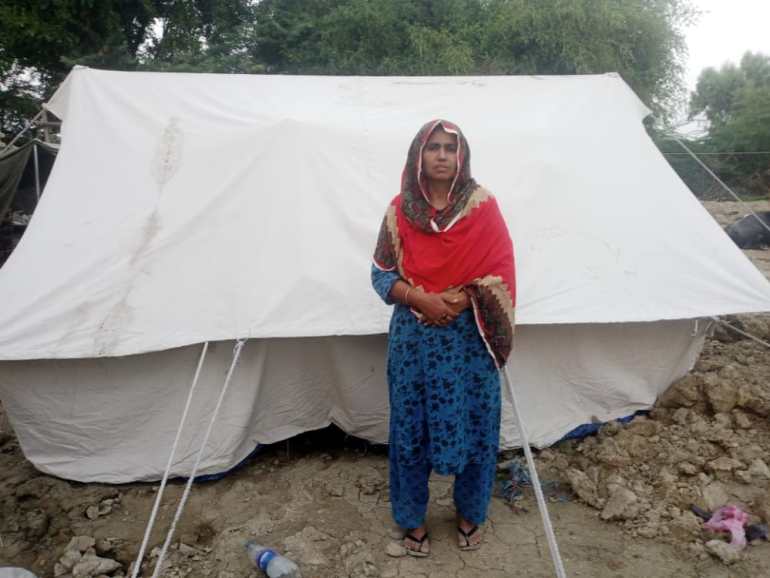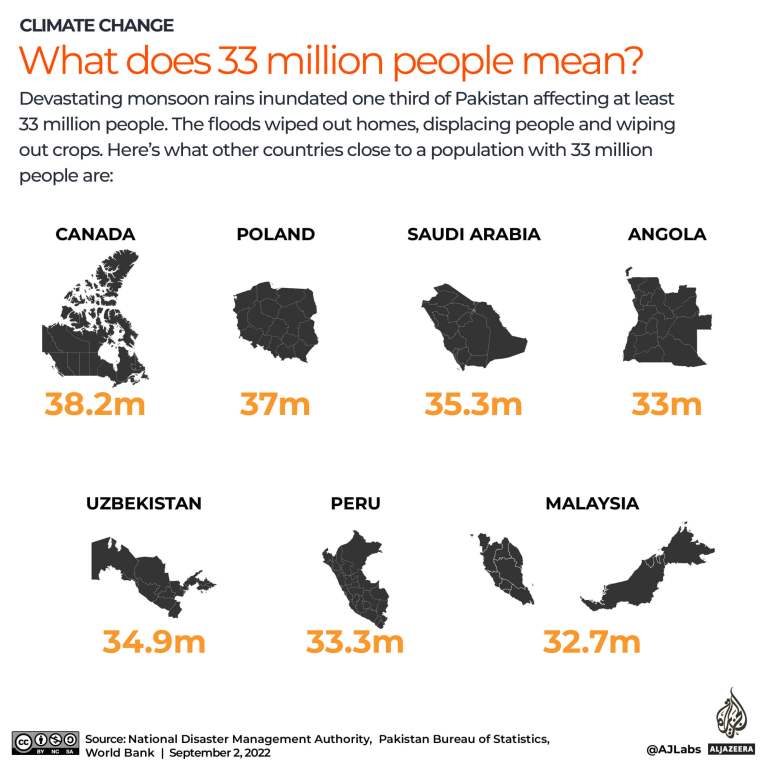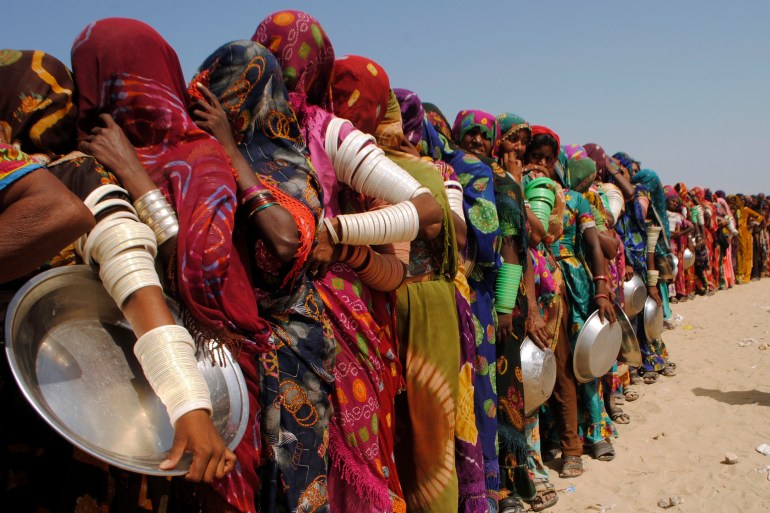Islamabad, Pakistan – It has been two weeks since Hasina Mugheri returned to her village in Pakistan’s southern province of Sindh, which was devastated by unprecedented floods in August.
Every day, Mugheri relives the trauma of the evening that she and her household have been compelled to evacuate from their residence within the village of Khair Muhammed Mugheri due to the rising, dashing floodwaters. She was 10-weeks pregnant.
“We did ultimately handle to search out [a] roof over our heads, so I’m very grateful to god for that,” stated the 42-year-old.
“Nevertheless it prices me my youngster.”
Mugheri narrated how she, her husband and 21 members of their family spent the evening out within the open, earlier than strolling greater than 5 kilometers (three miles) within the rain and darkness to succeed in a authorities faculty within the metropolis of Johi the place they discovered shelter .
“Inside two days of reaching there, I began bleeding, and requested my husband to take me to the hospital. The docs stated that stress, and all of the strolling maybe brought on the lack of [my] being pregnant. However what else can I do now, besides praying,” Mugheri instructed Al Jazeera.

For Mugheri, the lack of her being pregnant was a painful reminder of the final main flood in her village in 2010. Then, too, she misplaced a baby who was solely seven days previous.
The repeated trauma despatched her spiraling into melancholy, she stated.
“I final had a daughter 9 years in the past. I’ve already endured a number of miscarriages. You all the time hope for one of the best and are trying ahead to changing into a mom once more however then issues like this occurred,” she recalled.
“I used to be simply utterly bedridden in a room full of individuals, with no privateness, and no house to grieve.”
One in 5 million girls
Mugheri is likely one of the 5 million girls of reproductive age who’re at present residing in squalid situations in Pakistan’s flood-affected areas, with a overwhelming majority within the worst-hit province of Sindh.
In response to the United Nations Inhabitants Fund (UNFPA), as of November 10, greater than 400,000 girls are at present pregnant within the flood-affected areas of Pakistan, with one other 136,000 girls anticipated to offer start within the subsequent three months.
Dr Nighat Shah, a girls’s well being specialist related to Karachi’s Aga Khan Hospital, stated that greater than maternal and reproductive well being points, it’s their psychological well being that considerations her most.
“We’ve gone to a number of camps throughout Sindh the place hundreds of girls are stranded, residing in terrible situations, and the displacement has brought on immense trauma to them,” she instructed Al Jazeera.
Whereas the floodwaters have began receding, permitting many to return to no matter is left of their houses, there may be little hope for the tens of millions of people that have misplaced their belongings and technique of livelihood.

Counting the associated fee
Not less than 1,739 folks, together with 647 kids, have died and 33 million folks have been affected after record-breaking rains started lashing Pakistan in June, based on the nation’s catastrophe administration authority.
Sindh and the adjoining province of Balochistan remained the worst hit, with 799 and 336 deaths, respectively.
At their peak, the floods, attributable to a “monsoon on steroids” as described by the United Nations chief Antonio Guterres, left greater than one-third of the nation submerged.
It resulted in injury to greater than 13,000km (8,000 miles) of highway networks in addition to greater than two million homes, which have been both partially or utterly destroyed. 1,000,000 livestock was misplaced in addition to hundreds of acres of agricultural land.
In response to the Publish-Catastrophe Wants Evaluation report ready by the federal government, with help from the UN and different worldwide organizations, the overall injury is estimated to exceed $14.9bn, and whole financial losses to succeed in about $15.2bn.
Each day struggles proceed
However for hundreds of girls like Mugheri, it’s a day by day battle that overshadows the massive numbers and systemic, infrastructure points.
Tasmina, a 25-year-old mom of two, stated she had no alternative however to promote her wedding ceremony ring, a present from her mom, to purchase medicines for her household and herself.
She stated her husband and kids have been affected by malaria, whereas she was down with gastroenteritis, after they have been residing in a camp for displaced folks close to Johi metropolis in Sindh.
“My ring, which was a marriage current from my mom was price 10,000 rupees ($44). However after we all fell sick, I did not have cash to purchase medicines. I ended up promoting it for 3,500 rupees ($15),” she instructed Al Jazeera.
Recalling her time on the camp the place she spent greater than two months, Tasmina stated the situations have been horrific, with no sanitation or hygiene companies, as lots of of women and men have been compelled to make use of the identical non permanent rest room amenities, with restricted water.
“Once I bought [my] intervals, it turned much more troublesome and embarrassing for me. There was no segregation, no clear material was obtainable, and never sufficient water to scrub what I had with me. Simply eager about that point is making me cry. Solely god is our witness how we spent these days,” she instructed Al Jazeera.

Girls suffered probably the most
Raheema Panhwar, the provincial coordinator for WaterAid, a non-profit group that works within the space of sanitation and hygiene, instructed Al Jazeera that whereas the floods inflicted ache and distress throughout communities, it was the ladies who usually suffered probably the most.
“Many women face trauma and nervousness, significantly those that began their intervals for the primary time. They really feel disgrace and worry as a result of they have no information of the way to handle their intervals. And there’s no sufficient help from the household as a result of circumstances,” she stated.
Dr Muhammed Juman, the overall director of well being in Sindh, acknowledged that the scope of the catastrophe had made it extraordinarily troublesome to supply aid.
Girls have suffered nervousness and trauma, which is commonly mirrored within the varied illnesses they face, he stated.
“We’ve directed a lot of our feminine well being staff to go to those camps and places the place affected communities are, they usually have carried out hundreds of periods. Nevertheless it actually is a query of capability. The flood brought on infrastructure injury, leading to affecting service supply,” he stated.
Juman stated they have been making an attempt to coach their well being staff to supply psycho-social help.
“There are a number of psychological points that are being reported, and we have to put together for that. We’re participating feminine employees, equivalent to extra docs, midwives, nurses, and so on.”
How and what to rebuild
Mugheri, who now lives in a tent along with her husband and 5 kids when the floods destroyed her home, wonders how she is going to rebuild her life.
“I simply want God didn’t put anyone else by means of this distress. I usually get panic assaults and I keep awake all evening,” she stated.
“I endured one flood, however this time, issues are a lot worse, and for us girls, issues are far harder for us.”
